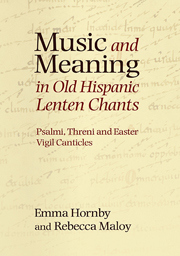Book contents
- Frontmatter
- Contents
- List of Music Examples
- List of Figures
- List of Tables
- Preface
- Abbreviations
- Manuscript Sigla
- Introduction
- CHAPTER 1 Thematic Congruity in the Old Hispanic Lenten Liturgies
- CHAPTER 2 The Threni
- CHAPTER 3 Melodic Language in the Old Hispanic Lenten Psalmi
- CHAPTER 4 Words and Music in the Psalmi
- 5 The Easter Vigil Canticles
- Afterword: Some Thoughts on the Relationship between the Old Hispanic Traditions A and B
- APPENDIX 1 A Guide to Reading Old Hispanic Notation
- APPENDIX 2 The Threni Texts
- Bibliography
- Index of Manuscripts Cited
- Index of Chants Cited
- Index of Scholars Cited
- General Index
- Studies in Medieval and Renaissance Music
CHAPTER 4 - Words and Music in the Psalmi
Published online by Cambridge University Press: 05 December 2013
- Frontmatter
- Contents
- List of Music Examples
- List of Figures
- List of Tables
- Preface
- Abbreviations
- Manuscript Sigla
- Introduction
- CHAPTER 1 Thematic Congruity in the Old Hispanic Lenten Liturgies
- CHAPTER 2 The Threni
- CHAPTER 3 Melodic Language in the Old Hispanic Lenten Psalmi
- CHAPTER 4 Words and Music in the Psalmi
- 5 The Easter Vigil Canticles
- Afterword: Some Thoughts on the Relationship between the Old Hispanic Traditions A and B
- APPENDIX 1 A Guide to Reading Old Hispanic Notation
- APPENDIX 2 The Threni Texts
- Bibliography
- Index of Manuscripts Cited
- Index of Chants Cited
- Index of Scholars Cited
- General Index
- Studies in Medieval and Renaissance Music
Summary
In Chapter ι we argued that the Old Hispanic Lenten liturgical texts are carefully selected and tailored to convey a coherent theological message. In Chapter 3 we analysed the melodic grammar and stylistic norms of the psalmi melodies. Building on that foundation, we now turn to the texts of the psalmi and the relationship between melody and text. The primary objectives of this chapter are to show how the texts of the Lenten psalmi participate in the Lenten themes identified in Chapter 1 and how the melodies read those texts. We argue that the psalmi melodies convey their texts in ways that sometimes help to communicate the key themes, particularly through contrasts in the melodic pacing of text delivery. This chapter begins with an introduction to our analytical methodology and continues with a summary of some general text-music tendencies we have observed in the genre. After two focused case studies that illustrate the range of our findings, we then turn to readings of individual texts and melodies, which constitute the greater part of the chapter.
METHODOLOGY FOR EXAMINING TEXTS
The psalmi and biblical exegesis
As shown in Chapters 1 and 2, the Old Hispanic Lenten liturgy follows a particular thematic trajectory, moving from a penitential focus in the first half of Lent to the Passion in the second half. Christian initiation also plays an important role in the season's liturgy. These themes are reflected in the text selection for the psalmi, which comes clearly into focus when we consider the texts in conjunction with their patristic commentaries. To understand why particular psalm verses were chosen for use in the Old Hispanic Lenten and Passiontide psalmi we examine patristic commentaries on the psalms, citations of these texts in seventh-century Iberian writings, and the liturgy itself.
- Type
- Chapter
- Information
- Music and Meaning in Old Hispanic Lenten ChantsPsalmi, Threni and the Easter Vigil Canticles, pp. 155 - 243Publisher: Boydell & BrewerPrint publication year: 2013

